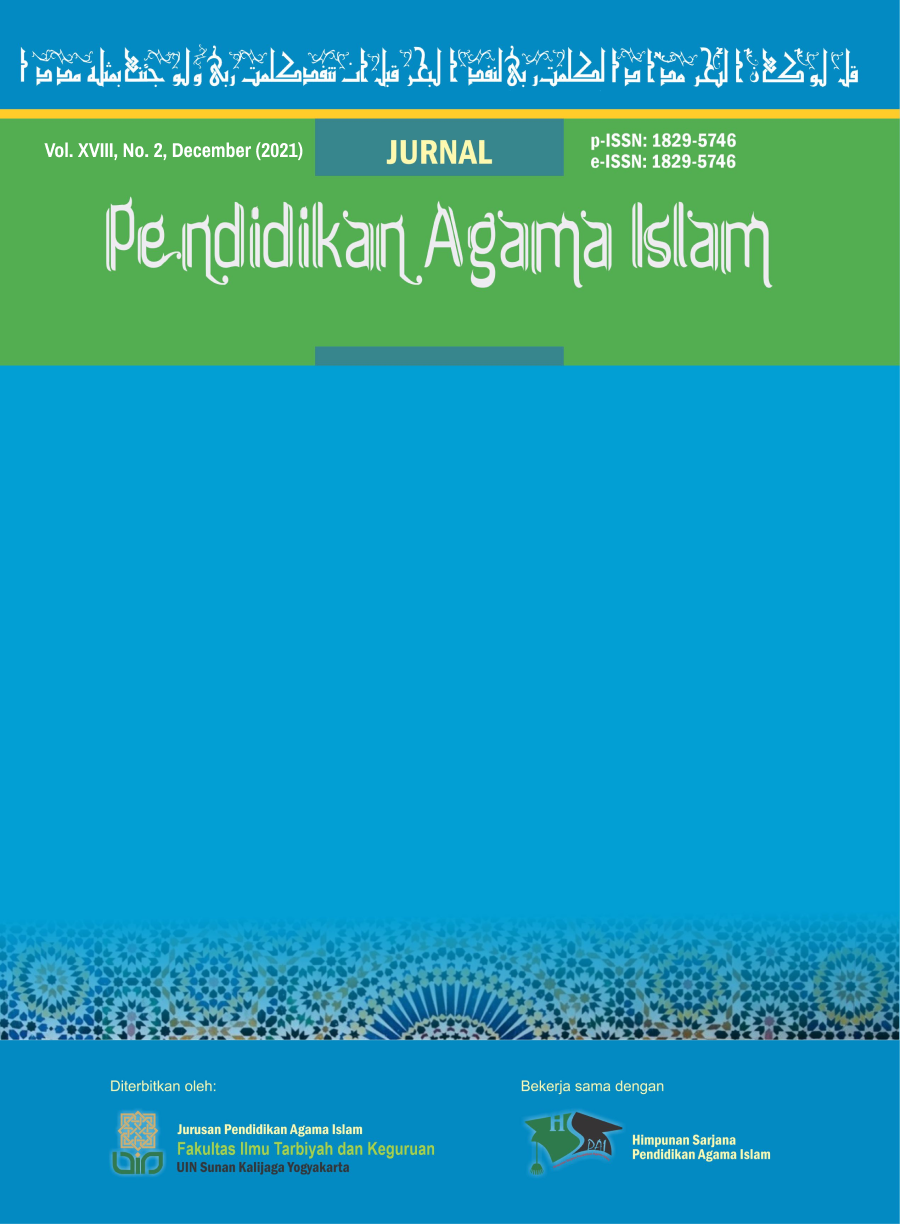Learning Communication in Tahfidz Quran Through Tarkiz Method
##plugins.themes.bootstrap3.article.main##
Abstract
This study aims to examine how the learning in Tahfidz Quran through the Tarkiz method. The researcher also analyzed the implementation of the Tarkiz method in learning tahfidz Quran by students, teachers, and Tarkiz’s coordinator. This research is qualitative with a case study approach in revealing Tarkiz's learning communication because social, cultural, and human behavior phenomena are not enough to record things that appear real. Therefore, they must also be examined in the context behind them. The results obtained in this study are in the form of a Welas Asih communication model in tahfidz Quran that can build commitment in human relations so that an educative interaction learning can be realized.
Keywords:
Downloads
##plugins.themes.bootstrap3.article.details##
Copyright
Copyright Notice
Authors who publish with this journal agree to the following terms:
- Authors retain copyright and grant the journal right of first publication with the work simultaneously licensed under a Creative Commons Attribution License that allows others to share the work with an acknowledgement of the work's authorship and initial publication in this journal.
- Authors are able to enter into separate, additional contractual arrangements for the non-exclusive distribution of the journal's published version of the work (e.g., post it to an institutional repository or publish it in a book), with an acknowledgement of its initial publication in this journal.
- Authors are permitted and encouraged to post their work online (e.g., in institutional repositories or on their website) prior to and during the submission process, as it can lead to productive exchanges, as well as earlier and greater citation of published work.
References
Allan K. Goodboy. (2018). Instructional Communication Scholarship: Complementing Communication Pedagogy. Journal of Communication Pedagogy, 1(1), 9-11.
Anas Sudijono. (2011). Pengantar Evaluasi Pendidikan. Jakarta: Rajawali Pers.
Anaas Tri Ridlo Dina Yuliana, Subiyantoro. (2017). Peran Kepemimpinan Pendidikan Islam dalam Manajemen Perubahan pada Lingkungan Organisasi Pendidikan di Madrasah Ibtidaiyah An-Nuur, Ngangkrik Triharjo Sleman. Tadris: Jurnal Pendidikan Islam, 12 (2), 146-160
Arifin, Zainal. (2013). Evaluasi Pembelajaran: Prinsip, Teknik, Prosedur. Bandung: Remaja Rosdakarya.
Asmani. (2012). Buku Panduan Internalisasi Pendidikan Karakter di Sekolah. Yogyakarta: Diva Press.
Bekti Taufiq Ari Nugroho. (2016). Efek Metode Pembelajaran Tahfidzul Qur’an Terhadap Prestasi Belajar Tahfidzul Qur’an. Jurnal Pendidikan dan Budaya Islam: Attarbiyah, 1(2), 211-242.
Darn, Steve. (2007). Aspect of Nonverbal Communication. Turki: Izmir University.
Deddy Mulyana. (2018). Metodologi Penelitian Kualitatif Paradigma Baru Ilmu Komunikasi dan Ilmu Sosial Lainnya. Bandung: Rosda Karya.
Dewi Puspitasari. (2012). Strategi Pembelajaran Terpadu. Yogyakarta: Familia.
Dimyati & Mudjiono. (2014). Belajar dan Pembelajaran. Jakarta:Bumi Aksara.
Farris, K. L., Houser, M. L., & Hosek, A. M. (2018). Historical Roots And Trajectories Of Instructional Communication. In M. L. Houser & A. M. Hosek (Eds.), Handbook Of Instructional Communication: Rhetorical And Relational Perspectives (2nd ed). New York: Routledge.
John W, Cresswell. (2014). Qualitative Inquiry and Research Design: Choosing Among Five Traditions. The USA: Sage Publications, Inc.
Littlejohn, Stephen. (2016). Teori Komunikasi. Jakarta: Salemba Humanika
Marno dan M. Idris. (2014). Strategi, Metode dan Teknik Mengajar. Yogyakarta: Ar-Ruzz Media.
M. Suyudi & Anang Prakasa. 2020. Pola Pembelajaran Pendidikan Agama Islam Pada Siswa Tuna Rungu Wicara di SDLB Negeri Punung Pacitan. Tadris: Jurnal Pendidikan Islam, 15(2), 320–333.
Miles, Matthe. B & Huberman, A. Michael. (2007). Analisis Data Kualitatif: Buku Tentang Sumber Metode-Metode Baru. Jakarta: UI Press.
Mulyasa. (2010). Menjadi Guru Profesional Menciptakan Pembelajaran Kreatif dan Menyenangkan. Bandung: Rosdakarya.
Mustakim. (2012). Psikologi Pendidikan. Yogyakarta: Pustaka Belajar.
Myers, S. A., Tindage, M. F., & Atkinson, J. (2016). The Evolution Of Instructional Communication Research. In P. L. Witt (Ed.), Handbooks Of Communication Science: Communication And Learning (Vol. 16). Berlin, Germany: DeGruyter/Mouton.
Nofha Rina. 2016. Pembentukan Konsep Diri Anak Melalui Komunikasi Dakwah. Jurnal LISKI 1(2), 104–115.
Nurfuadi & Moh. Roqib. (2017). Kepribadian Guru. Purwokerto: STAIN Press & Grafindo Litera Media.
Nurul Hidayah. (2016). Strategi Pembelajaran Tahfidz Al-Qur’an Di Lembaga Pendidikan. Ta’allum: Jurnal Pendidikan Islam 1(1), 63-81.
Purwanto, M. Ngalim. (2017). Psikologi Pendidikan. Bandung: Rosdakarya
Robert J., Strenberg & Karin Strenberg. (2012). Cognitive Psychology. USA: Wardsworth.
Robert. G. Powell & Dana L. Powell. (2015). Classroom Communication and Diversity: Enhancing Instructional Practice. 3rd Eds. New York: Routledge.
Saroni, Muhammad. (2006). Manajemen Sekolah: Kiat Menjadi Pendidik Yang Kompeten. Yogyakarta: Ar Ruzz.
Safrudin Aziz. (2019). Keberhasilan Program Tahfidz Al-Qur’an Kejar Paket B Darul Qur’an Al-Karim Baturraden Banyumas T.A 2018-2019. Tadris: Jurnal Pendidikan Islam 14(2),161-174.
Setiawan. (2017). Belajar dan Pembelajaran. Ponorogo: Uwais.
Sihabudin Afroni dan Rumba Trian. (2018). Komunikasi Pembelajaran Berbasis Al-Qur’an. Jurnal Pendidikan Islam 7(2), 157-177.
Silberman, Mel. (2013). Pembelajran Aktif 101 Strategi Untuk Mengajar Secara Aktif. Jakarta:Indeks.
Sipos. (2015). A Framework for Success School – 11 Principles of Effective Character Education. USA: Character.Org.
Slameto. (2015). Belajar dan Faktor-Faktor Yang Mempengaruhinya. Jakarta: Rineka Cipta.
Steve Darn. (2018). Aspect of Nonverbal Communication. Turki: Izmir University.
Subaidi. (2019). Pendidikan Karakter Berbasis Budaya Islamidi MTs. Tahfidz Yanbu’ul Qur’an Menawan Kudus. Tadris: Jurnal Pendidikan Islam 14(2), 189-199.
Timothy. P. Mottet, Virginia. P. Richmond & James. C. McCroskey. (2016). Handbook of Instructional of Communication. Rhetorical and Relational Perspective. New York: Routledge.
Titsworth, S., Mazer, J. P., Goodboy, A. K., Bolkan, S., & Myers, S. A. (2015). Two Meta Analyses Exploring The Relationship Between Teacher Clarity And Student Learning. Communication Education 64 (4), 385–418.
Thomas S.C. Farrel. (2018). Talking, Listening, dan Teaching. California: Corwin.
Yusma Ihda Rohmawati. (2018). Pengaruh Menghafal Al-Qur’an Terhadap Akhlak Siswa Madrasah Tsanawiyah Sunan Pandanaran Kabupaten Sleman Yogyakarta. Universitas Islam Indonesia: Yogyakarta.
Wardah Wafiyah Mubarakah & Erni Munastiwi. (2020). Pelaksanaan Program Tahfidzul Qur’an Berbasis OnlineMasa Pandemi Covid-19”. Tadris: Jurnal Pendidikan Islam 15(2), 184-194.
Yosal Iriantara. (2014). Komunikasi Pembelajaran: Interaksi Komunikatif dan Edukatif Di Dalam Kelas. Bandung: Simbiosa Rekatama.
567
Views
464
Downloads





